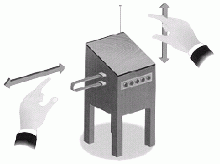|
You're watching an old horror movie, and as the creature approaches the teenagers sitting in the car, you suddenly hear from the screen a shrill, wavy sound, like a sharp, vibrating bow ... a mysterious sound that's hard to identify. Like this. That's the sound of a theremin, and it's unlike any instrument you've ever heard or seen before. The theremin has no moving parts, and you don't touch it to play it ... you make sounds by moving your hands through a field of electromagnetism! Music is produced by waving your hands near the two antennas; the instrument contains no moving parts. The theremin produces electric fields surrounding each of the two antennas; these fields are affected by the proximity of some other object, like a hand. Moving your hand varies the sound, as explained below.  When a hand is brought into the sensitive electric field surrounding the vertical antenna, sounds are produced. These are amplified through a loudspeaker. As the hand approaches the antenna, the pitch of the sounds becomes higher; as the hand is with-drawn, the pitch becomes lower. When a hand is brought into the sensitive electric field surrounding the vertical antenna, sounds are produced. These are amplified through a loudspeaker. As the hand approaches the antenna, the pitch of the sounds becomes higher; as the hand is with-drawn, the pitch becomes lower.
As a hand approaches the horizontal antenna, the loudness decreases; as the hand is moved away from the antenna, the power is increased, to an intensity exceeding that of the most powerful stringed instrument. No special knowledge is needed to play it ... anyone who can hum or whistle a tune can play the theremin. But it requires practice to play well. The theremin does not sound like any other single instrument. Vibrato, glissando and other musical effects are accomplished easily, and it can produce not merely quarter tones, but infinitesimal divisions of tone. Its range is about three octaves. When playing low tones, it can be made to sound like a bassoon or string bass. In the mid-range of frequencies, it is very similar in sound to a cello; at higher ranges it imitates the violin and flute. At its highest frequencies, the theremin sounds very much like a soprano human voice. By rapidly changing the tones being played, the resulting combinations of sounds can only be described as 'other-worldly' ... there is nothing else like it.  Inside the instrument, besides the electric field generator, there is a tone generator and an amplifier. The first theremins contained vacuum tubes to amplify the sounds, but most modern ones are use transistors. Inside the instrument, besides the electric field generator, there is a tone generator and an amplifier. The first theremins contained vacuum tubes to amplify the sounds, but most modern ones are use transistors.Robert Moog, a pioneer designer and manufacturer of commercial music synthesizers, began his career by building versions of the theremin in the 1960s. It has since become very popular. But the theremin was a neglected instrument during the first half of the last century. Its unusual sound was made use of mostly by movie producers, who used it in such movies as 'Lost Weekend', 'The Day The Earth Stood Still', 'The Thing', and 'Alice in Wonderland'. By the mid 1960's, however, the music industry had discovered the instrument, and since then has been featured in the music of various artists, including 'Good Vibrations' by the Beach Boys, 'Whole Lotta Love' by Led Zeppelin, and more recently, The Jon Spencer Blues Explosion, Pere Ubu, Phish, and The Lothars. In the past few decades, new advances in the field of electronic music have seen the development of synthesizers, drum machines and samplers ... but Termen's theremin was the original electronic instrument, and its sound remains unique. According to Jason Barile, of the Center for Intelligent Systems (CIS), at Vanderbilt School of Engineering, "When you play a theremin, you essentially become part of the circuit. The simplicity of the design is the most interesting technical aspect of the instrument... there are no mechanical or moving parts involved; itís just pure electricity." Are you intrigued? Before you rush out and buy yourself a theremin, why not try one, right here on your computer? We found a site with a unique interface that allows you to actually play a theremin and hear what it sounds like. Visit this site, Turn your volume way up, and you will be amazed at the sounds you can make! Click on the 'off' button at the top left to turn on hand recognition with your webcam; back up so that your face and hands line up, and you can play the theremin very much like a real one. |